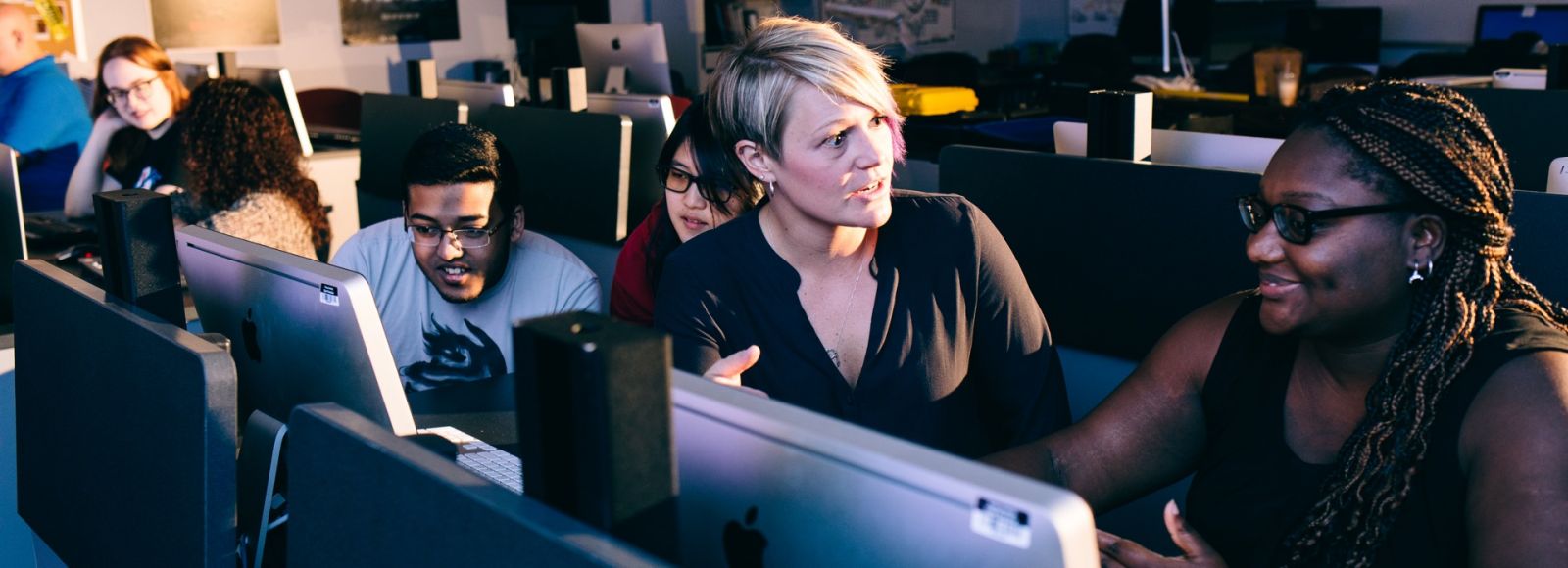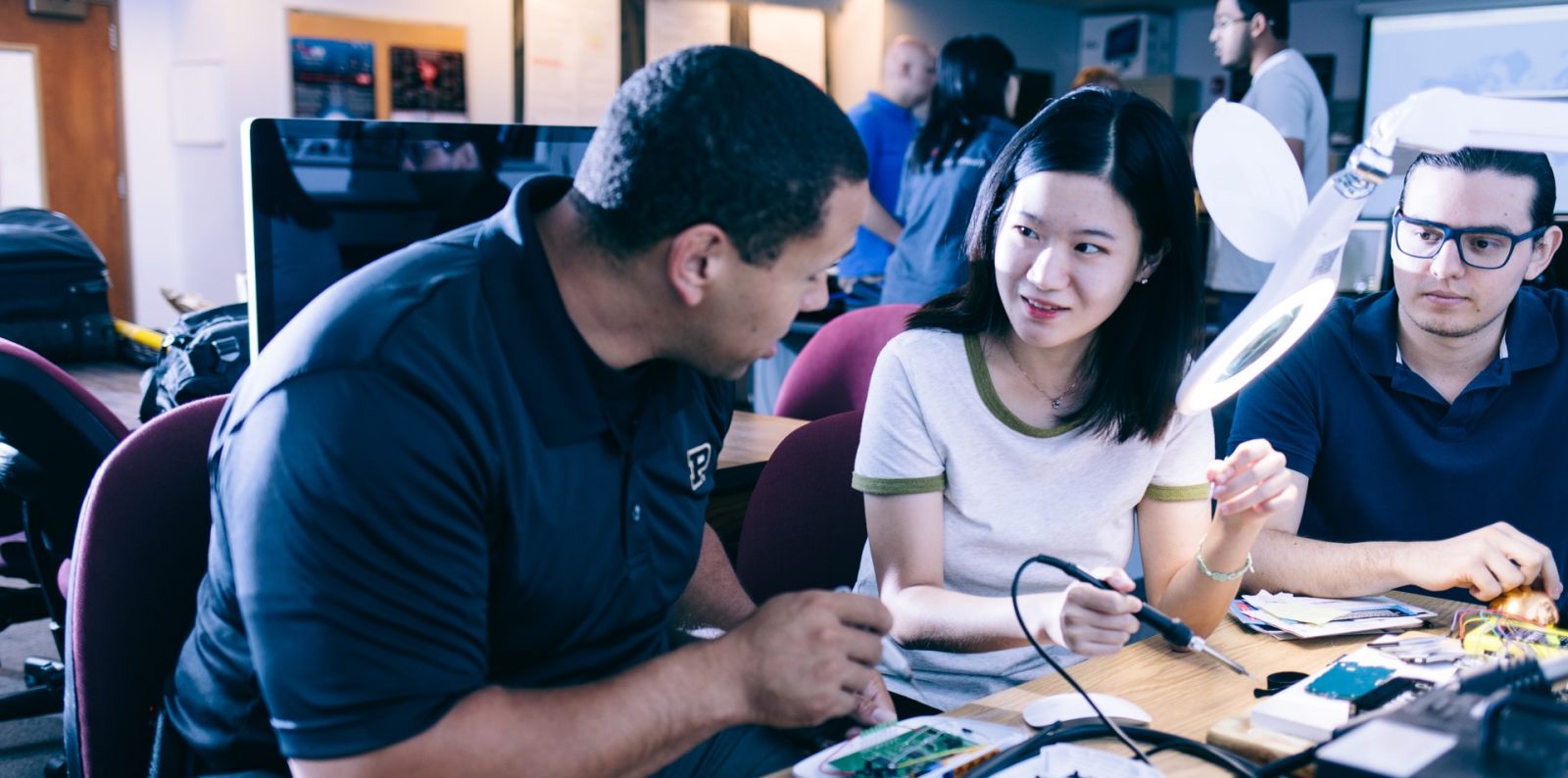To promote Purdue Polytechnic’s learning environment and majors online and in print, high quality photographs of our people and facilities are essential. We can help organize a photo session, including helping determine when hiring a professional photographer is necessary.
Just as knowing how to drive does not make each of us ready for a racetrack, having access to a good camera does not make capturing the right photos easy. To capture photos which present our college in the best possible light, there are many important factors to consider.
People
Who should be in the photos? Invite students, faculty and/or staff who are in the specific school, department or program, if possible. Make a very strong effort to achieve gender balance and to feature underrepresented minorities; it’s okay for students to invite friends to help out, even if they’re in other majors, to provide good balance and diversity.
How many people should come? Consider the capacity of the location, and then invite enough people so that the space will look comfortably occupied but not crowded. It’s helpful to have several groupings of three to four people each.

Clothing. Subjects should dress casually and comfortably, as for a 70ºF day (not too lightly, not too heavily). Clothing with large brand logos or slogans should be avoided, although Purdue University apparel and Polytechnic "I'm A Techie" shirts are encouraged. “Business casual” is appropriate for faculty/staff. In lab environments, subjects should always wear appropriate protective clothing and required safety gear.
Release/consent forms. We follow the Office of Marketing and Media’s guidelines for filming on campus. For planned photo sessions, we will ask student subjects to sign a release/consent form.
Time and Logistics
Achieving professional-quality results requires considerable attention to detail, and this requires significant time. For each small grouping of people in each location, plan a 60-minute window in which the location and all subjects (the people serving as “actor/models” and all equipment and/or other materials to be included) are ready to work with and accept direction from the photographer. Ideally, the primary purpose for gathering at the designated date and time should be photography rather than an academic class or lab period. This is the best way to get the highest number of “keeper” photos during the time allotted.
Location Prep
Presentation. Whether the photo session location is a lab, classroom, conference room, office or hallway, it should be clean and presentable. Spaces should appear actively used and “lived in,” but clutter should be minimized and organized.
It’s also important to make the entire room presentable. Some photos will be composed as a very wide frame (people in the middle, potentially unoccupied portions of the room on the sides) for website banner graphics.

Technology. Subjects working at computer screens should call up content which looks as discipline-specific as possible. For example, at a cybersecurity lab photo session, computer screens were filled with forensic analysis of images, computer code, and unique software tools rather than ordinary content (i.e. surfing the web, writing documents or spreadsheets, or files/folders on the desktop).
Ideally, all visible computer screens should be on and displaying discipline-specific content. Any visible technology, equipment or gear that has status lights and/or control screens should be powered on, if possible.
Subjects working with physical artifacts should similarly choose discipline-specific items and equipment.
Activities
We will instruct the photographer to capture images that feature “active learning” and teamwork in which students are engaged with their hands and/or technology, in groups of two to four people, with some individual shots. We do not need “passive learning” photos (e.g. listening to a lecture).
For photos featuring faculty/student interaction, faculty should appear as a mentor or guide with the students rather than in a towering, authoritative role over the students. In many situations, the ideal contextual balance can be achieved when, for example, the faculty member is sitting when some or all of the students are sitting.
Delivery
In professional photography, the photo session is not the final step; rather, it's only one step in the process of creating the desired results. Editing the photos may require at least as much time, if not significantly more, as the photo session itself. Expect delivery of the first photos from a session at least one week later; more time may be required for lengthier and/or more complex sessions.
Scheduling
Contact us to begin the process of organizing a photo session. Please consider some of the following issues:
- How will the photos be used? (Examples: Print publications; masthead banners on websites; illustrative photos surrounded by article text; email messages.)
- What is the ideal location to capture representative images?
- Is there a specific week or time of the year when activities take place which would provide the best possible visuals? For example, to use certain equipment, to have required materials on hand, for subjects to have progressed far enough in assigned design projects, or similar logistical considerations, would a photo session have to be scheduled during a specific portion of the semester?
- Is a pre-scheduled academic lab or class period the only time feasible for a photo session? Although this may be doable, expect delivery of fewer photographs from the session.
Release/Consent Form
As noted above, we follow the Office of Marketing and Media’s guidelines for filming on campus. For planned photo sessions, student subjects should sign a release/consent form.
